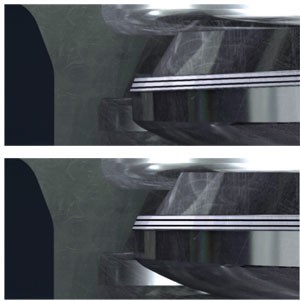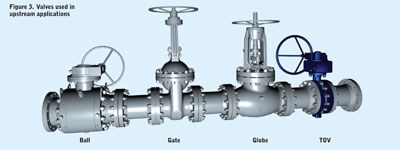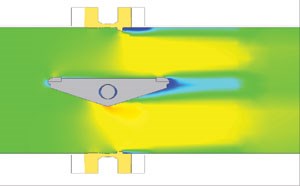Triple Offset Valves in Upstream Applications
Triple offset valves provide an efficient solution for critical and non-critical applications when positive isolation is required in upstream oil and gas operations.
#actuators
Most onshore and offshore installations traditionally use ball valves and occasionally gate valves for the majority of flow isolation applications. Specifications typically call for 6D valves, but engineers seldom look beyond these specifications to other valve types with similar or better performance.
Many of these engineers are not yet aware that in many offshore isolation applications, a triple offset valve (TOV) offers benefits in terms of weight, overall dimensions and performance versus the standard ball or gate valve. A TOV can be the right choice for applications in the turret of a floating production storage and offloading vessel (FPSO), and in virtually all topside process applications of FPSOs and platforms such as separators, water treatment, gas compression and other systems.
Today’s TOVs, with pressure ratings up to ASME Class 1500 and zero leakage, cover enough applications to achieve significant savings in weight and space, as well as total cost of ownership.
HISTORY
The TOV design was introduced in the early 1970s as the next great development after the high-performance butterfly valve. The design is totally different from conventional or high-performance butterfly valves, however, offering a 90-degree non-rubbing rotation and metal-seated zero leakage.
Since the TOV was introduced, it has become a success with end users in the downstream oil and gas, process and power industries. It is recognized as a reliable, robust and valid alternative to gate and globe valves as well as ball valves.
The TOV concept is applied in a wide variety of applications from cryogenic to high temperature and from low- to high-pressure where positive isolation is required. Since its introduction, more than 500,000 TOVs have been installed worldwide with an extremely wide range of sizes and ratings and different materials—from WCB to duplex and from CF8M to titanium.
DESIGN
In the triple offset geometrical design of TOV, the valve shaft is double offset relative to the seat axis and to the symmetrical axis of the valve. This allows for a camming action of the disc as it rotates. In addition, the valve seat is manufactured in a conical form where the apex of the cone has been oriented to an asymmetrical axis of the valve, which introduces a third offset. This characteristic eliminates any rubbing action of the seal ring with the seat during the 90 degrees of rotation.
The disc is not a sealing element, so it often consists of the same material as the body. As a result, there is no temperature limitation because of thermal expansion and contraction up to the limit imposed by ASTM on WCB (800° F or 426° C).
An important advantage of the TOV design is that the valve is torque-seated, which is a significant difference from position-seated, high-performance butterfly valves where only the position and the interference between the sealing elements generate tightness.
In a high-performance butterfly valve, a stopper is cast into the body to prevent the disc going through, which would have catastrophic consequences. Because the seat is the natural stopper in a TOV, it is physically and mechanically impossible for the disc to go through under any service conditions. This design reduces maintenance and substantially extends the life expectancy of the valve with corresponding advantages in operability and possible speed of operation.
ACTUATION
The torque in a TOV remains constant throughout the life of the valve—independent of cycles, temperatures or applications. As a result, safety factors are not as much a consideration when selecting an actuator. This makes actuator selection for a TOV reliable and more economical than selection would be, for example, with ball valves. Sizing an actuator for a ball valve would necessitate high safety factors to accommodate the increase in torque during the ball valve lifetime because of 100% rubbing rotation. The initial torque of the actuator required to operate the ball valve could be insufficient after the valve has been in service for a number of years. This is not the case with a TOV, where torque is a constant value during its lifetime.
TESTING
It is important to emphasize how testing is conducted in a controlled manner of a TOV to be sure that zero leakage is achieved.
The standard test procedure for all TOVs is a zero leakage bench test that allows “open face” testing (in other words, no blind flanges, pipes or bubblers are used) and always applies a controlled torque. This allows an inspector to observe the sealing surfaces of the valve when under pressure and eliminates any form of manipulation of the test to hide possible leakage, even in the relatively short test time specified by international standards.
Torque should also be continually measured and monitored during testing of both gear-operated and actuated valves. It is important to note that at no time during testing should an operator be allowed to increase torque, even if this will result in better sealing. This is a fundamental requirement to ensure reliable actuator selection and to maintain valve tightness performance over the time in service.
ZERO LEAKAGE
Zero leakage is defined as the ability to pass a test with no visible leakage during test duration as defined by API 598 and API 6D. All TOVs, gear-operated or actuated, must be zero leakage with controlled torque.
For many valves, bubble-tight is adequate, but this fails to recognize that the valve is leaking. Bubble-tight, in accordance with FCI 70-2 Class V or Class VI or 598 and API 6D metal-seated means “allowable leakage.” For example, FCI 70-2 cl.VI for an 8-inch valve allows 40 bubbles per minute when tested at 3.5 bar air; 598 leakage is measured in drops per minute (liquid) and bubbles per minute (air), while 6D and FCI 70-2 leakage is measured in milliliters per minute.
ADVANTAGES OF A TOV UPSTREAM/OFFSHORE
TOVs offer several advantages compared to other valves typically used in most upstream applications. Compared to a soft-seated ball valve, the TOV is inherently fire safe with a non-rubbing rotation. No safety factors are required in actuator sizing and the valve opens against full delta P (no equalizing pressure is required). It requires less maintenance, offers better control capabilities, and ultimately reduces the space, weight and cost.
A soft-seated ball valve is also zero leakage. However, the soft components are limiting in terms of applicability and, more importantly, the life expectancy of the valve. A TOV achieves the same performance with metal-to-metal sealing, virtually no temperature limitation and a much more extended product life.
If necessary, a TOV can open against full-rated differential pressure in all classes up to ASME Class 1500. This is not possible with ball valves where it may be necessary to have a small bypass line to equalize upstream and downstream pressure to open the valve. This additional pipe and valves will not only increase the overall cost of the unit but will add potential points of leakage and failure.
Because of the weight and space savings, always an important consideration offshore, installation of TOVs is easy and simple when compared to ball valves. The valves are easy to operate and are an excellent choice for ESD (emergency shutdown) and HIPPS (high-integrity pressure protection system) applications. Whatever the required closing time is, it can be achieved and maintained for a very long time with a TOV. TOVs are used as standard for trip applications by major turbine manufacturers.
This article is focused on the zero leakage capabilities of TOVs in isolation applications. However, TOVs also can be used for control applications. Furthermore, the triple eccentric design offers advantages over traditional high-performance butterfly valves. One TOV can be used at the same time for both control and isolation, replacing the two valves normally used (butterfly for control and ball for isolation). Conventional ball valves are not used in control applications.
WEIGHT AND SPACE SAVINGS
In addition to operational advantages the TOV offers a significant savings in weight and space, which will have a positive impact in the overall spending on valves. The simple rule is that the larger the size and the higher the rating, the larger the savings a TOV can offer. With reduced weight, especially when using exotic materials, the total cost of ownership can be reduced.
COMMON MISCONCEPTIONS
Another perception is that when the TOV is fully open, there may be a considerable pressure drop because of the presence of the disc and shaft in the middle of the line. A calculation with oil at 90 bar and a velocity of 3 meters per second in a 14-inch ASME Class 600 TOV shows that once the valve is in the fully open position, the pressure drop in this particular case would be only 0.07429 bar.
CONCLUSION
Triple offset valves are a serious, robust and reliable alternative to traditional ball valves for many offshore applications in the upstream oil and gas segment. TOVs can provide reductions in weight and space and substantial cost savings with medium and large valves on the topsides of floaters and platforms, as well as in FPSO/floating storage and off-take turrets.
Pieter Kok is upstream market manager at Tyco Flow Control (www.tycoflowcontrol.com). Reach him at pkok@tyco-valves.com.
RELATED CONTENT
-
Grease for Motor Actuator Maintenance
Maintaining the right amount of grease inside motor actuators that use grease for lubrication is a vital part of valve maintenance, and can save time and money by preventing problems before they happen.
-
The Actuators That Drive Subsea Operations
Subsea development includes different types of activities such as exploration, drilling, completion and production.Subsea manifolds are the arrangement of piping, valves, connections, structures and the foundation used in the subsea production system to receive, combine and distribute the hydrocarbon fluid
-
New Requirements for Actuator Sizing
After decades of confusion, the American Water Works Association has created new standards for actuator sizing that clear up some of the confusion and also provide guidance on where safety factors need to be applied.












 Unloading large gate valve.jpg;maxWidth=214)


